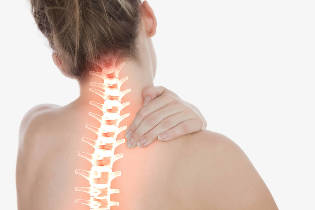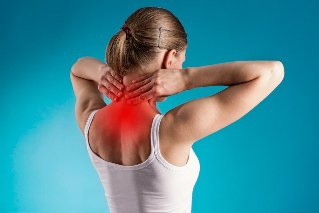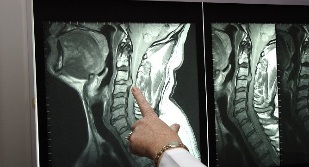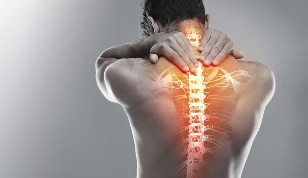Osteochondrosis cervical — degenerate-dystrophic process in the intervertebral discs of the cervical spine, accompanied by a replacement of the cartilage of the bone and immobilisation of the spinal column. According to the statistics, those or other degenerate-degenerative changes of the cervical spine are present near the half of people of working age from 25 to 45 years.

Causes and risk factors
The anatomical characteristics of the cervical column and create the preconditions for the development degenerated-of the degenerative changes. The cervical vertebrae of a segment differ from a maximum of mobility, to carry out all kinds of movement in its entirety, because it is exposed to early wear and tear.
On the prevention of cervical osteoarthritis it is necessary to think still in their infancy.
The development of cervical osteoarthritis have a sedentary way of life, especially the habit of sitting down, the neck stretched forward, which intensifies the pressure on the intervertebral discs, which leads to the deformation and dehydration polosnyj institute. The degeneration of the cartilage and worsen the violations of the food chain due to the compression of the vessels spasserovannye muscles. Progressing downstream of the cervical arthrosis the following factors contribute to:
- congenital anomalies of the structure of the vertebrae;
- endocrine disorders;
- autoimmune collagen diseases (rheumatism and systemic lupus erythematosus);
- torticollis new-born;
- the dysplasia of the head of the hip joint;
- flat feet;
- the violation of posture and the curvature of the spine;
- injuries and repetitive strain injuries of the cervical spine;
- smoking and alcohol abuse;
- long emotional distress;
- a hereditary predisposition.
The development of cervical osteoarthritis is also conducive to the long-term poisoning of the body during a stay in an environment that is disadvantaged land, the regular contact with dangerous substances, and the availability of foci of chronic infection in the body.
The symptoms of cervical osteoarthritis
In the early stages of degenerated by the degenerative process, the disease is almost asymptomatic. Unpleasant sensations in the neck occur only with sudden movements after a long period of conservation in tense, sedentary, poor posture and the misalignment of the head or in response to excessive physical exercise. The development of myositis accompanied by a sense of discomfort, and clearly the location of the pain indicates the spasms in the muscles of the neck.

Decompensated cervical osteochondrosis is characterized persistent discomfort in the neck, a familiar muscle tension and limitation of mobility of the cervical spine segment; force the position of the head in the smooth part of the discomfort. In the turns and slopes of the head, often heard the crunch of the vertebrae. The subluxation intervertebral joints are accompanied by acute burning pain, commonly referred to as the heat could, and vegetative of mental disorders: dull headache, dizziness, darkening in the eyes, heart palpitations, etc, Spontaneous, open reduction of sub-luxation brings quick relief.
In the case of the formation of osteophytes and extrusions to the rear of the vertebrae of the general manifestations of the cervical osteoarthritis will be added by the following root canal symptoms:
- headache, localized in the nape of the neck, and parietal;
- the decrease of the sensitivity of the skin to one side of the neck;
- the disorders of speech and numbness of the tongue;
- the discomfort in the external surface of the shoulder;
- disorders of the respiratory tract.
In lesions of osteochondrosis of the third cervical vertebra sometimes observed the reflex of the syndrome kardialgichesky – pain behind the sternum (breastbone) to the shoulder blade and the shoulder, causing the association with a heart attack, especially if the pains are accompanied by rapid palpitations. In case of defeat, the last three vertebrae of the pain and paresthesias are distributed with the neck on the scapula, the arm, the brush and the fingers. Patients may complain of numbness of the upper limbs, a burning sensation, tingling or "chills" on the road of nerves are.
The development of cervical osteoarthritis have a sedentary way of life, especially the habit of sitting down, the neck stretched forward.
Osteophytes, located on the lateral surfaces of the vertebrae compress the vertebral artery, causing the services of violations of cerebral circulation, which is called the syndrome of the vertebral artery. This pathology is manifested by frequent episodes of crashing headache, which extends from the nape of the neck on the top of the head and of the whisky, giving in to the eyeballs. In some cases, instead of headaches, constant feeling of heaviness in the head. Simultaneously, we observe vegetative symptoms:
- swings of blood pressure;
- seizures and cardiac arrhythmias;
- migrenepodobnie unilateral throbbing headache accompanied by photophobia, nausea and vomiting;
- the violation of thermoregulation (chills, sweats, cold extremities);
- dizziness, fainting, and drop-attacks;
- disorders of coordination of movements;
- the noise and congestion in the ears;
- decrease of visual acuity and visual disorders: darkening and diplopia, blurred vision, flash and multi-colored flies before the eyes;
- sleep disorders;
- fatigue and emotional lability.
The diagnosis
Because of the low specificity of symptoms and the great diversity of the manifestations of diagnosis of cervical osteoarthritis is made in several steps. It is necessary to begin with the consultation of a specialist, a ben the ado orthopedic surgeon, a neurologist or vertebrologist. Presumptive diagnosis is based on patient's complaints, data anamnestiques and the results of the physical inspection. During the examination, the patient, the doctor draws attention to the mobility of the neck, the sensitivity of the skin and painful to the cervical area of the range and the schedule, the strength and tone of muscles, the severity of the tendon reflexes.

To determine the stage of the disease and identify complications, the patient is sent to the MRI of the cervical spine. Thanks to the quality of the visualization of the hard and soft tissues of the tomograms shows all the symptoms of cervical arthritis – reducing the height of the intervertebral discs, osteophytes, priest, extrusion, damage to nerves and blood vessels, calcification of ligaments, foci of bone resorption, the myositis and the flow into the muscles.
In dealing with economic matters, has not the time to stand on tip-toe, or keep the arms raised above the head; it is better to use a ladder or standing on the stool.
In case of unavailability of the MRI scan is performed the x-ray or a ct scan of the neck segment on the detection of osteophytes, osteoarthritis and reduced bone density. The changes of the soft tissues are visualized with the aid of ULTRASOUND for the study of the hemodynamics and the assessment of the extent of the damage of the blood vessels during the performance of a cervical osteochondrosis prescribe Doppler of the vessels of the neck, and in the event of a suspected spinal cord injury – the contrast myelography.
The treatment of cervical osteoarthritis
Osteochondrosis of the cervical spine requires a complex treatment. During the aggravations of the main task of therapy boils down to relieve the pain kupirovaniyu the inflammatory process and the restoration of capillary blood flow in the affected regions. Patients are prescribed analgesics or nonsteroidal anti-inflammatory drugs, which prefer the inhibitors of cyclo-oxygenase-1 on the basis of diclofenac and nimésulide. When the muscle spasms, it is recommended to wear a neck brace; if necessary, prescribe anti-spasmodics and muscle relaxants.
When the radicular syndromes with a poor response to drug therapy use of x-rays controlled blockages disadvantaged roots and steroid injections. To improve the metabolism in the intervertebral discs and damaged nerve structures shows the stability of intake of vitamins of the group S. Complicated of the extrusion, a spinal cord injury and refractory pain syndrome are indications for surgery.
The full recovery of the intervertebral disc, osteochondrosis is unlikely, but with the help of timely and adequate therapeutic measures, you can stop or slow down the progression of degenerated by the degenerative process.
To measure the attenuation of the acute symptoms begin rehabilitation aimed at the activation of the blood supply in damaged areas and the recycling of the products of inflammation. Well-established of electrophoresis and phonophoresis, magnetotherapy, amplipuls-wave therapy shock-wave therapy, UHF and diadynamic.
The rapid recovery of mobility of the cervical spine, contribute to the training in groups, GYMNASTICS, swimming and aqua aerobics. You can treat, and at home: the most effective exercises when osteochondrosis cervical do not require special equipment and training. The daily, the rehabilitation programme is designed for 15-20 minutes and consists of five simple exercises. Each exercise is repeated 5 times in the slow, flowing rhythm, gradually increasing the number of repetitions to 10-12 times.
- The twists and turns and rotation of the head to the right and to the left while maintaining the same position of the head and shoulders.
- Alternating the tightening of the forehead and the nape of the neck on the palm of the hand, with a small tension in the muscles of the neck.
- Head tilt, curved back, to the strap hole and on the side. When it is tilted towards the right, you must touch the right ear to the right shoulder and the left ear up to the left shoulder.
- The tightening on the left the temple of the palm of the left hand, and then to the right the temple of the palm of the right hand.
- The tilt of the chin to the neck with a rotation of the head to the right, then to the left.
The means of alternative medicine should be treated with the utmost care, and to coordinate their application with the treating physician. In the absence of contraindications, you can take a course of reflexology, osteopathy and hirudotherapy; chiropractic treatment is strictly contraindicated. By a regular therapeutic massage in osteochondrosis cervical gives more encouraging results, without exposing the patient to unnecessary risk.
The possible complications and consequences of the

In the neck region is concentrated the largest number of the plexus and the blood vessels, including the vertebral artery and the nerve vertebral. The joints that connect the speakers to the front edges of the vertebrae, are prone to dislocations and subluxations, and the triangular-shaped intervertebral holes in the last three cervical vertebrae increases the likelihood of infringement of the nerve root, bone, glands and spasserovannye muscles. As a result, the risk of joining the syndromes of compression in the low back pain cervical more than in the defeat of the other departments of the vertebral column.
In the early stages of the disease of complications, primarily related to the scoliosis, and muscle spasms. The syndrome of muscle scalene develops during the long pressure nerve of the brachial plexus and the subclavian artery spazmirovannah in front of the muscle scalene. Reflex irritation of the nerve fibres and absence of blood flow to the muscle tissue is manifested by pain of the forearm and the wrist, which is reinforced by the inclined position of the head and abduction of the hand. When the displacement of the great vessels is celebrated on the cooling and swelling of the limbs.
The appearance of extrusions and osteophytes, accompany the syndrome's root, which, in turn, may complicate the violation of the spinal cord. The compression of the spinal cord often becomes the cause of paralysis of the upper limbs, and in more serious cases life-threatening due to the strong oppression of respiratory function. Heavy syndrome of the vertebral artery, circulating on the backdrop of marked ataxia and decompensated neurocirculatory dysfunction, is threatening to become a disability and increases the risk of ischemic stroke and spinal cord ischemia.
Forecast
The full recovery of the intervertebral disc, osteochondrosis is unlikely, but with the help of timely and adequate therapeutic measures, you can stop or slow down the progression of degenerated by the degenerative process, prevent complications and maximize the preservation of the mobility of the cervical spine. During the execution of osteochondrosis of the cervical spine, combined with multiple extrusions and compression syndromes, the forecast is the most conservative.
Prevention
On the prevention of cervical osteoarthritis it is necessary to think still in their infancy. The formation of a correct posture, consistent muscle strengthening dorsal and nutrition will help you maintain the health of the spine in adulthood. During the identification of the child disorders of posture, flat feet, and of the generic outcomes of injury, such as a stiff neck or dysplasia of the head of the hip joint, it must not neglect the scope of the programmes: a pathology of the locomotor apparatus, the osteochondrosis, are successfully treated in the ossification of the skeleton.

If the profession of the patient involves a sedentary lifestyle, it is necessary to choose an ergonomic office chair with the support of the neck, and in the bedding set included mattress and a low firm pillow. Sleep on the sofas and beds with shielded the grid is not recommended; it is best to choose a model with a moderately tight surface. During the time of working through all the 45 to 60 minutes, it is desirable to perform exercises for the neck, and at leisure, do some physical exercise, and most often walk around on foot. A good effect to give swimming lessons and aqua aerobics, yoga, qi gong and pilates classes; power and traumatic sports of the exclude. During the course, it is necessary to avoid sudden movements and keep your back straight. In dealing with economic matters, has not the time to stand on tip-toe, or keep the arms raised above the head; it is better to use a ladder or standing on the stool. Two to three times in the year not difficult to follow a course of therapeutic and preventive massage cervico-zone.
The diet should be a sufficient amount of protein, vitamins and minerals, it is recommended to include in the menu, the jelly, the neck of the fish and seafood are sources of natural collagen. The refusal of bad habits, and helps to keep active blood circulation in the intervertebral disks.


















































